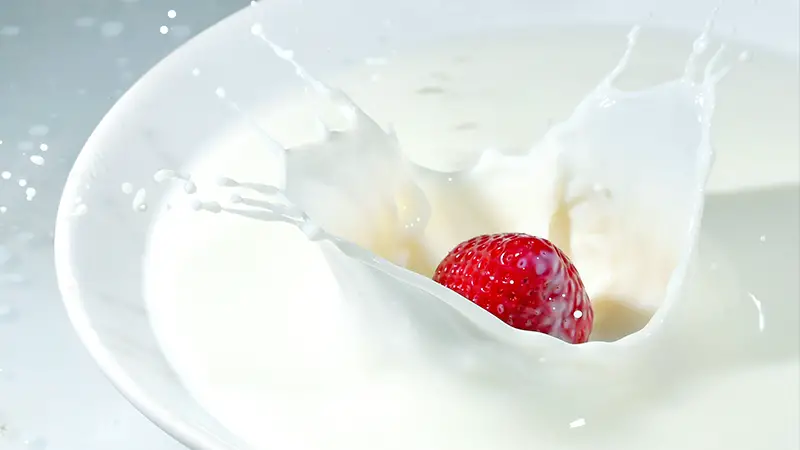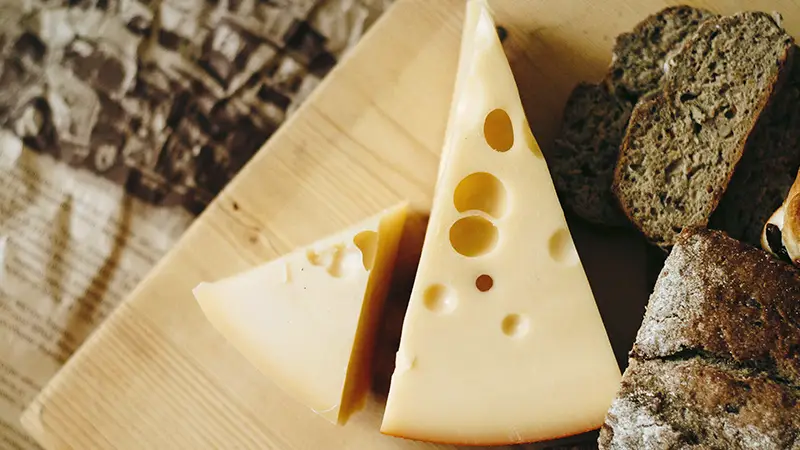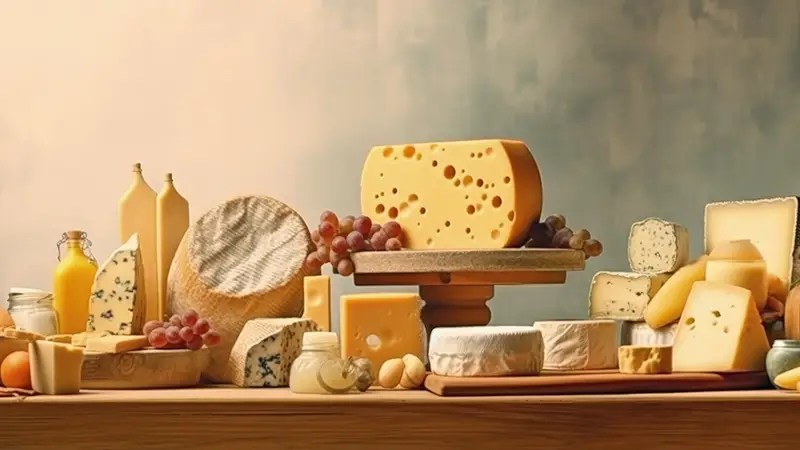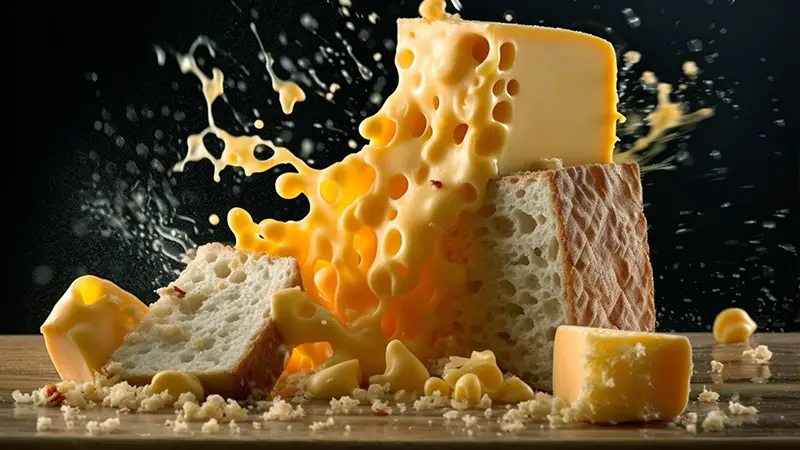Dairy products are a staple in many diets around the world, providing essential nutrients like calcium and protein.
Yet, within this creamy realm, there’s a puzzling contrast when it comes to carbohydrates: milk, the primary dairy source, is carbohydrate-rich, while cheese, a popular dairy derivative, is nearly carb-free.
This intriguing paradox begs the question: Why does milk have carbs but not cheese?
The answer lies in the fascinating world of dairy processing. From the cow’s udder to the cheese platter, a transformation occurs that alters the nutritional composition.
This journey is not only insightful but also crucial for those managing their carbohydrate intake, such as individuals with lactose intolerance or low-carb diets.
In this blog post, we’ll unravel the science behind this phenomenon, exploring the cheese-making process, the role of lactose, and how cheese becomes a low-carb delight. Stay focused.
Nutrition Fact of Milk

The nutrition facts of milk can vary slightly depending on the type of milk (whole, skim, 2%, etc.) and whether it’s fortified with vitamins and minerals.
Here are the approximate nutrition facts for one cup (240 mL) of whole cow’s milk, which is a common reference point:
- Calories: 150
- Total Fat: 8 grams
- Saturated Fat: 5 grams
- Trans Fat: 0 grams
- Cholesterol: 24 milligrams
- Sodium: 105 milligrams
- Total Carbohydrates: 12 grams
- Dietary Fiber: 0 grams
- Sugars: 12 grams (naturally occurring lactose)
- Protein: 8 grams
- Calcium: 276 milligrams (about 25% of the Daily Value)
- Vitamin D: 127 IU (about 15% of the Daily Value)
- Vitamin A: 112 IU (about 2% of the Daily Value)
- Vitamin B12: 1.1 micrograms (about 46% of the Daily Value)
- Potassium: 366 milligrams
It’s important to note that these values are approximate and can vary depending on factors such as the brand of milk and the cow’s diet.
Additionally, if you’re consuming a different type of milk (such as almond, soy, or oat milk), the nutritional content will differ significantly.
Nutrition Fact of Cheese

The nutrition facts for cheese can vary widely depending on the type of cheese and its fat content.
Here are approximate nutrition facts for a 1-ounce (28-gram) serving of regular cheddar cheese, which is a common type of cheese:
- Calories: 110
- Total Fat: 9 grams
- Saturated Fat: 6 grams
- Trans Fat: 0 grams
- Cholesterol: 30 milligrams
- Sodium: 180 milligrams
- Total Carbohydrates: 0 grams
- Dietary Fiber: 0 grams
- Sugars: 0 grams
- Protein: 7 grams
- Calcium: 204 milligrams (about 20% of the Daily Value)
- Vitamin D: 1 IU (less than 1% of the Daily Value)
- Vitamin A: 270 IU (about 6% of the Daily Value)
- Vitamin B12: 0.5 micrograms (about 21% of the Daily Value)
Please keep in mind that these values are approximate and can vary depending on the specific type and brand of cheese.
Cheese comes in many varieties, including different fat levels, so the nutritional content may differ significantly between types of cheese.
Why Does Milk Have Carbs But Not Cheese?
Milk contains carbohydrates, primarily in the form of lactose, while cheese typically has very few carbohydrates or even none.
This difference in carbohydrate content between milk and cheese is due to the cheese-making process. Here’s why:
Lactose Content
Milk contains lactose, a type of sugar naturally found in milk. Lactose is a carbohydrate, and it’s the primary source of carbs in milk.
It provides energy and serves as an essential nutrient for infants, helping them grow and develop.
Cheese-Making Process
When cheese is made, one of the steps involves fermenting milk with bacteria or enzymes to convert lactose into lactic acid. This fermentation process reduces the lactose content significantly.
Additionally, cheese-making typically involves separating the solid curds from the liquid whey. Most of the lactose remains in the whey, which is separated from the curds. As a result, cheese ends up with very little lactose.
Aging
Some types of cheese undergo an aging or ripening process. During this time, any remaining lactose is further broken down by the bacteria used in the cheese-making process.
This contributes to the cheese’s low carbohydrate content.
Variability
It’s important to note that the carbohydrate content of cheese can still vary somewhat depending on the type of cheese and the specific manufacturing process.
Some fresh cheeses, like cottage cheese or ricotta, may have slightly higher lactose content compared to aged cheeses like cheddar or Swiss.
Milk contains carbohydrates because of the presence of lactose, while cheese has very few carbohydrates or none due to the fermentation and separation processes involved in cheese-making.
The Cheese-Making Process and What Happens to the Carbs in the Milk?
The cheese-making process involves several steps that transform milk into cheese. Here’s an overview of the process and what happens to the carbohydrates (primarily lactose) in the milk:
Curdling
The cheese-making process typically begins by adding a coagulating agent, such as rennet or an acid (like vinegar or lemon juice), to milk.
This causes the milk to curdle and form solid curds and liquid whey. The curdling process separates the proteins and fats in the milk from the liquid components.
Cutting and Draining
Once the curds have formed, they are cut into smaller pieces to facilitate the release of whey. The curds are then heated, allowing them to contract and expel more whey. This step helps reduce the lactose content further.
Fermentation
Many cheese varieties involve the addition of specific bacterial cultures to the curds. These cultures play a crucial role in cheese development.
They consume some of the remaining lactose, converting it into lactic acid and other compounds. This fermentation not only contributes to the cheese’s flavor but also further reduces the lactose content.
Pressing
The curds are often pressed to remove even more whey and compact them into a solid cheese shape. This process can vary depending on the type of cheese being made.
Aging (Ripening)
After shaping, some cheeses undergo an aging or ripening process. During this time, various biochemical changes occur. The remaining lactose is often broken down by the bacteria used in fermentation.
Other enzymes and microorganisms present during aging contribute to the development of flavor and texture in the cheese. Aging can last for weeks, months, or even years, depending on the type of cheese.
Final Whey Removal
The cheese may be allowed to drain further to remove any remaining whey before packaging.
The end result of this process is cheese with significantly reduced lactose content compared to milk.
Most of the lactose remains in the liquid whey, which is separated from the solid curds during cheese-making.
Cheese Varieties and Carbohydrate Content

The carbohydrate content in cheese can vary significantly depending on the type of cheese.
Here’s a general overview of some popular cheese varieties and their approximate carbohydrate content per 1-ounce (28-gram) serving:
Cheddar Cheese
Cheddar is a relatively low-carb cheese with less than 1 gram of carbohydrates per ounce.
Mozzarella Cheese
Mozzarella is also low in carbs, containing less than 1 gram of carbohydrates per ounce.
Swiss Cheese
Swiss cheese has a minimal carbohydrate content, typically less than 1 gram per ounce.
Brie Cheese
Brie is a soft cheese with a slightly higher carb content than some other varieties, usually around 1 gram per ounce.
Blue Cheese
Blue cheese contains approximately 1-2 grams of carbohydrates per ounce.
Cottage Cheese
Cottage cheese, which is a fresh cheese, has a slightly higher carb content than aged cheeses, with about 3-4 grams of carbohydrates per 1/2 cup (4-ounce) serving.
Ricotta Cheese
Ricotta cheese, another fresh cheese, contains around 3-4 grams of carbohydrates per 1/2 cup (4-ounce) serving.
Cream Cheese
Cream cheese is relatively low in carbs, with about 1-2 grams of carbohydrates per 1-ounce serving.
Parmesan Cheese
Parmesan is a hard cheese and is extremely low in carbohydrates, containing less than 1 gram per ounce.
It’s essential to note that these values are approximate and can vary slightly depending on the brand and specific product.
Additionally, fresh cheeses like cottage cheese and ricotta tend to have slightly higher carbohydrate content than aged, hard cheeses like cheddar or Parmesan.
Importance of the Element in Cheese for Human Body

Cheese is a dairy product that contains various essential nutrients and elements that can be beneficial for the human body when consumed in moderation. Here are some of the important elements of cheese and their roles:
Protein
Cheese is an excellent source of high-quality protein, which is essential for the body’s growth, repair, and maintenance of tissues. Protein is crucial for building muscles, enzymes, and hormones.
Calcium
Cheese is rich in calcium, a mineral vital for strong bones and teeth. Adequate calcium intake is essential for preventing conditions like osteoporosis and maintaining bone health throughout life.
Phosphorus
Cheese contains phosphorus, which is important for bone health and the formation of DNA and RNA. Phosphorus also plays a role in energy metabolism.
Vitamin D
Some cheeses are fortified with vitamin D, which helps the body absorb calcium. Vitamin D is essential for bone health, immune function, and overall well-being.
B Vitamins
Cheese provides various B vitamins, including B12 (cobalamin), B2 (riboflavin), and B3 (niacin).
These vitamins are essential for energy production, nervous system function, and the formation of red blood cells.
Vitamin A
Cheese contains vitamin A, which is important for vision, skin health, and the immune system. It also contributes to the health of various organs, including the heart and lungs.
Fats
Cheese is a source of saturated fats, which, when consumed in moderation, can provide energy and contribute to overall health.
Some cheeses are lower in fat than others, so you can choose options that align with your dietary preferences.
Sodium
Cheese can be high in sodium, which is essential for maintaining fluid balance and nerve function.
However, excessive sodium intake can lead to high blood pressure, so it’s important to consume cheese in moderation and choose lower-sodium options when possible.
Probiotics (in some varieties)
Certain types of cheese, such as yogurt-based cheeses like cottage cheese and some fermented cheeses, contain probiotics. These beneficial bacteria can support gut health and digestion.
It’s important to note that while cheese provides valuable nutrients, it should be consumed in moderation, especially if you are concerned about saturated fat and sodium intake.
FAQs
Why does milk have carbohydrates, but cheese doesn’t?
Milk contains carbohydrates in the form of lactose, a sugar naturally present in milk.
During cheese-making, most of the lactose is removed with the whey, leaving behind the curds. The curds are further processed and fermented, reducing the carbohydrate content in cheese.
Is all cheese carbohydrate-free?
No, not all cheese is carbohydrate-free, but most varieties contain very few carbohydrates.
Hard cheeses like cheddar and Parmesan have negligible carbs, while soft cheeses like Brie or cottage cheese have slightly more due to their lower moisture content.
Does cheese retain any lactose after processing?
Cheese retains very little lactose after processing. Most of the lactose is removed with the whey during cheese-making, and any remaining lactose is further broken down during fermentation and aging.
Can people with lactose intolerance eat cheese?
Many people with lactose intolerance can tolerate cheese because of its low lactose content.
However, sensitivity varies, so individuals with severe lactose intolerance may still experience symptoms with certain cheese types.
How do cheese-making processes differ from milk to cheese?
Cheese-making involves curdling milk to separate curds (which become cheese) from whey.
This separation, along with fermentation and aging, reduces lactose content. In contrast, milk retains its natural lactose content, making it higher in carbohydrates than cheese.
Wrapping Up
In the realm of dairy, the contrast between milk and cheese regarding carbohydrate content showcases the incredible versatility of these products and the science behind their transformation.
While milk serves as a nutrient-rich, carbohydrate-laden source, cheese emerges as a low-carb delight, thanks to meticulous cheese-making processes.
Why cheese is carb-light while milk is carb-rich not only satisfies curiosity but also aids dietary choices. For those seeking to reduce carbs or manage lactose intolerance, this knowledge empowers informed decisions.
So, as we enjoy the diverse world of dairy, we can appreciate the subtle intricacies that turn milk into cheese, offering both delicious flavors and valuable nutritional differences.
The dairy aisle, once a puzzle, now becomes a place of informed choices and culinary exploration. Best of luck.
I am a fitness instructor and I have been in the industry for 9 years. I have a passion for health and fitness.
I am a fitness instructor with over 9 years of experience in the industry. My passion is health and fitness and I would love to share my knowledge with you!